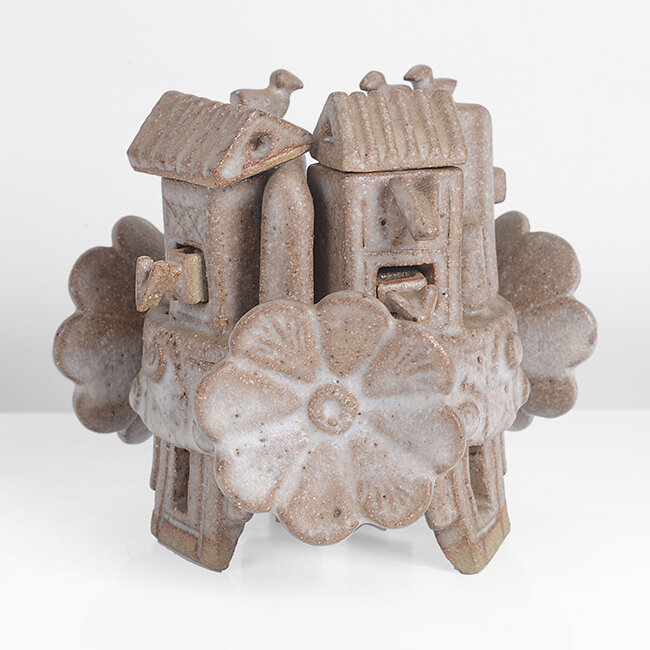Ian Godfrey: pathos and humour
Sitting on the floor at Oxford Ceramics Gallery, as we made an inventory of the works that had come in from the Estate of Ian Godfrey for the show Enchanted Landscapes, was a moment like no other for me. Surrounded by a menagerie of clay animals and teapots ranging in size from the pointlessly small to the ridiculously big, I was overwhelmed… where do you start? Which dimensions are we trying to record? What do you even call half of the objects?
“A prophet, in his modest way, of simplicity, yet fascinated by glamour, he is a great creator of fantasies.”1
Godfrey's very distinctive style owed much to Mediterranean, Middle Eastern, and East Asian influences. Most of his work was thrown, then worked with penknives and the tip of a ball-point pen and finished with a clear matt glaze. The designs tended towards the mystical, almost pagan, and often portrayed animals and houses or other architectural forms.
“He uses a wide variety of references to other cultures in his work and often his pots look like something unearthed from some odd, ancient civilization… For most, the eccentric fantasy world of Godfrey’s pots are [sic] a delight.”2
“Godfrey was a great artist-archaeologist whose knowledge and sifting of ancient cultures help him achieve his own level of playful and tactile intimacy with clay, taking us to a place both precious and enchanting.”3
Having studied under Ian Auld, Hans Coper and Lucie Rie at Camberwell College of Arts, Godfrey set up his first workshop in Islington, North London, close enough to the British Museum that he could visit frequently for inspiration. In the 1970s his work was attracting attention and success, but Godfrey left the UK to work in Copenhagen. On his return to England in the early 1980s he set up another studio in London, although for a long time he preferred not to exhibit formally and almost hoarded his own work. He finally exhibited at Galerie Beson in 1989.
“His art was celebratory, but also full of gentle pathos and humour… It was a place Ian made his own… he lived so much in his own universe and in the objects that came out of it.”4
Godfrey’s was a universe of historical references, classical inspiration and mysterious cityscapes or landscapes which were lived-in places. His Fox Boxes and lidded vessels are often inhabited by donkeys whose tracks cross between the buildings and opening them sometimes reveals a badling of ducks.
“Godfrey’s work had the directness of folk art, combined with the underlying complexity of Shang or Benin bronze vessels.”5
Godfrey’s vast knowledge of the British Museum’s ancient civilisations collections recurs throughout his work, particularly the Chinese and Mediterranean collections where his antelope heads and house forms most likely come from. But his work is also playful, fun and slightly childish – rattles, rocking horses and swinging birds, tiny drawers, impractical tea pots, removable elements, multiple ducks and antelope heads. They are objects that you want to touch and explore and understand but are ultimately fantastical enigmas; they are “… playful and humane and need to be handled and enjoyed. They should make us smile…”6
Picking up a small creature from amongst the objects on the floor in Oxford Ceramics Gallery and then realising it was a rattle was a heart-in-mouth moment – no one who has ever set up an exhibition wants to hear what sounds like loose pieces when they move an object! – but the joy of Godfrey’s work was still only just dawning on me. Everything about his work, when it’s in your hand, is tactile and playful. These intricate pieces with removable elements – ducks, lids, drawers – and these chaotic cityscapes with a resigned-looking donkey forever moving between two buildings or around the curvature of this particular clay world are objects that make you stop, explore and lose yourself in. Maybe not the most productive way of doing an inventory, but I can only imagine that is exactly the effect that Godfrey was aiming for.
Godfrey died young, leaving a legacy of work in many public collections around the world, including the V&A.
“He produced ceramics quite unlike anybody else, a wonderful conjuring in clay of a world that drew on his deep knowledge of ancient art and ritual… an extremely personal art of exotic beasts and buildings, of entrancing landscapes, full of Ian's particular brand of humour and whimsy…”7
These blog posts are published monthly, but if you want to access more exclusive content and to help my research, please consider supporting me on Patreon.
I also post photos daily to my Instagram profile.
1 - Paul Rice and Christopher Gowling; British Studio Ceramics in the 20th Century; 1989; Barrie & Jenkins Ltd
2 - Tony Birks; Art of the Modern Potter; 1976; Country Life Books
3 - David Whiting; Magical Landscapes – The Ceramic Art of Ian Godfrey (1942-1992); 2007; Galerie Besson
4 - David Whiting; An Enchanted Landscape; 2019; Oxford Ceramics Gallery
5 - Garth Clark; The Potter’s Art; 1995; Phaidon Press Limited
6 - David Whiting; An Enchanted Landscape; 2019; Oxford Ceramics Gallery
7 - David Whiting; Magical Landscapes – The Ceramic Art of Ian Godfrey (1942-1992); 2007; Galerie Besson
Edited by Sarah McGill
Ian Godfrey; Fox Box; c1970s; photo by Phil Sayer
Ian Godfrey; Double-Spouted Tea Pot
Ian Godfrey; Small Bowl
Ian Godfrey; Ring Landscape with Drawers
Ian Godfrey; Lidded Vessels




